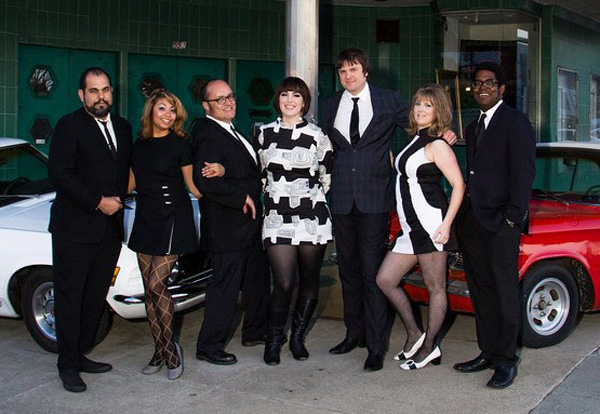When Derek See and Angeline King started the South Bay R&B girl group the Bang in late 2008, it wasn’t because they had some fleeting interest in 1960s music; the project was the byproduct of a lifetime’s obsession with the golden decade.
See, notably, has been running a website for the past six years called “Derek’s Daily 45,” which presents and reviews a different ’60s/’70s 45 record nearly every day, something he does because “the music is too good to not share.”
Before starting the Bang, King sang in a ’60s girl group in Chicago called the Deccas. It was an experience she says was “far more rewarding than anything else that had ever happened to me up to that point.” Though, more revealing is an admission that she always secretly wanted to be Tina Turner.
“This is not some schlocky, make-fun-of-the-’60s kitschy band or being ironic,” King says “It’s respecting the decade, because it’s such great music, and it has such great artists.”
King’s introduction to the music of the era actually came via her father, who had been in bands ever since she can remember. He was in one group in particular called the Id that released an obscure single called “Stop and Look” in 1967. And yes, See has reviewed this 45 on his blog.
One thing King’s father never got to do was cut an LP, though he told Angeline that she fulfilled his dream last November when the Bang released their debut album, Soul Shangri-La, appropriately on vinyl.
“He couldn’t believe it,” King says. “It blew his mind.”
The album is the perfect introduction for anyone yet unfamiliar with the Bang’s music. Shimmy Soul Shangri-La displays the wide range of content the Bang uses in its live sets. The ratio of covers to original material is about 70/30. The Bang’s current crop of covers ranges from recognizable classics like “Be My Baby” by the Ronettes to completely obscure tracks that only obsessive record collectors like See and his bandmates would ever recognize.
Besides King (vocals) and See (guitar), the lineup also includes Rachel Mae Havens on vocals, Tish Peterson on vocals, Richard Gutierrez on drums, Jafar Green on bass and Curtis Meacham on keyboards.
What is most impressive about the LP is how solid the original material sounds next to the covers. Listeners without some serious archivist’s knowledge of the music wouldn’t be able to pick out which songs were written by the Bang and which were penned back in the day.
The only real giveaway is the content of the lyrics. The Bang original “Drink in Hand,” for instance, includes clever stanzas in which singer Mae describes the ways that different alcoholic beverages affect her. Otherwise, this is precisely the kind of tune that could have been penned and released by a Phil Spector–produced girl group almost 50 years ago.
What makes the Bang’s original work so effective at evoking the ’60s spirit is due, in no small part, to their fanaticism. These armchair experts own 15,000 45s and 3,000 LPs.
“There’s a criteria for songs from the ’60s: They’re short, they move, they’re interesting and they have hooks,” See explains. “It’s just getting you in the gut. Even if it’s a ballad, it’s still moving.”
They also give the covers their own personality. While remaining faithful in their renditions, they transcribe the songs with a rhythm, pacing and overall feel that fits their distinctive groove, rather than trying to play all notes exactly as they sounded in the original.
Of all the work that went into Soul Shangri-La, a good portion was devoted to the recording method. See, along with recording engineer friend Brad McGowan, worked diligently to use, whenever possible, the same kind of equipment and techniques that were used by the bands they were covering. The rhythm section, for instance, recorded all its parts live. When the girls overdubbed their vocals, they did so all at once, in the same room with only two microphones for the three vocalists, the way they did it in the ’60s.
“Every other recording situation I’ve been in, I’ve compromised my vision. But this was the first time I said, ‘No. It has to be done this way,’” See tells me. “Brad had done a bunch of research about the Motown micing techniques. He was ready, and he was in our corner and just a great cheerleader for the whole thing.”
When the Bang make their next record, they plan to record mostly, if not exclusively, original material. They’ll never stop playing covers in their live set entirely, however. As See points out, the covers have their own spin to them. They are just Bang songs.
The Bang and the Bionic Vixens Revue
Saturday, April 6
More info.
.The Bang Revive the 60s with the Bionic Vixens Revue This Weekend




